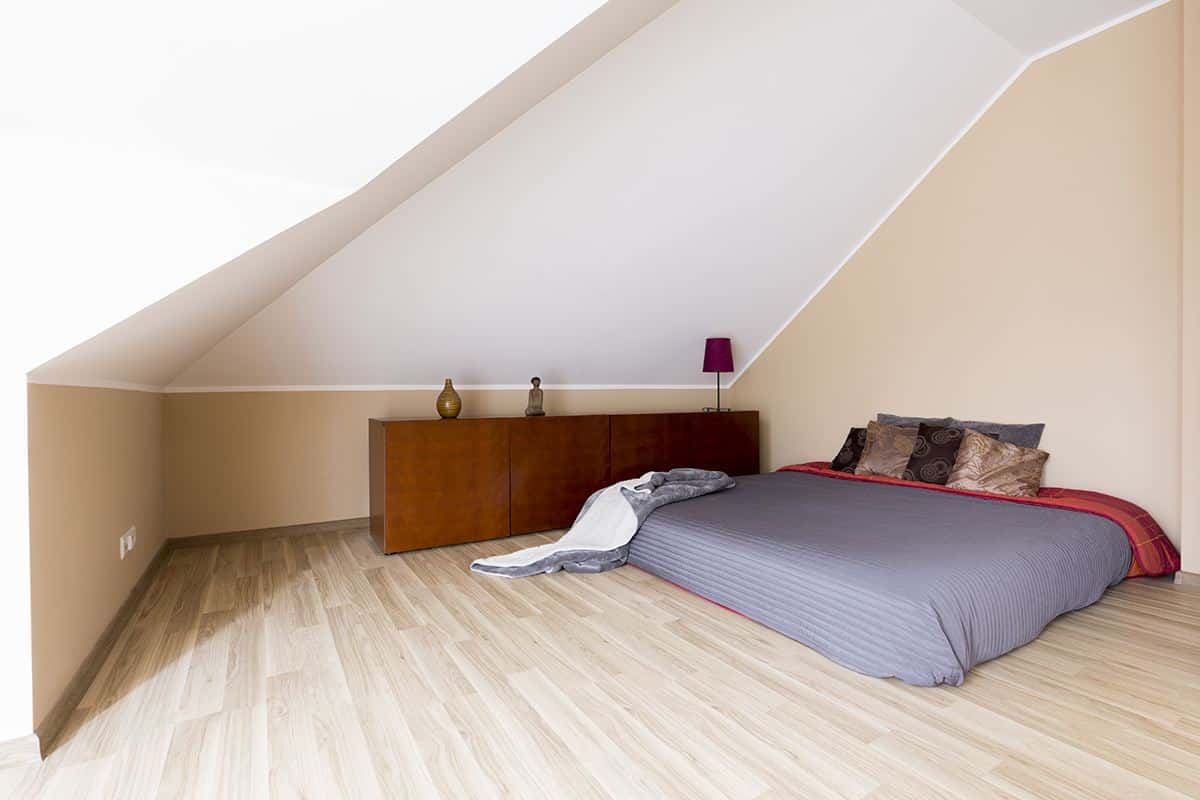When you’re furnishing your bedroom, it may feel like a bed frame or box spring is an absolute necessity. However, in many cultures, sleeping on a simple mattress or thin sleeping mat on the floor is standard practice. And in a few cases, it may make sense to sleep directly on the floor of your bedroom.
Sleeping on the floor is certainly nothing new. Anthropologists believe our ancestors slept on slim mats made of plants, and certain populations continue to sleep on the floor. More recently, proponents of the Paleo diet and lifestyle recommend sleeping on the floor as part of going “full caveman.”
Whether or not putting your mattress on the floor is a good idea depends on a few different things including the mattress type, flooring, and climate you live in.
So, what are the benefits and downsides of sleeping on the floor? Below, we’ll explore the pros and cons of putting your mattress on the floor to help you make an informed decision according to your unique sleep needs!
Pros of Sleeping with Your Mattress on the Floor
Even though some people associate a mattress on the floor with a youthful stage of life, there are several good reasons to put your mattress on the floor—no matter your age.
Good Support
Floors are guaranteed to be flat and firm, so they offer a decent support system for your mattress. If your choices are between the floor or a bed frame that’s cracked, wobbly, or sagging, then the floor is almost certainly a better bet. Not only does it guarantee support for your mattress, but it can also help you feel secure while sleeping.
Budget-Friendly
 One of the most obvious perks of putting your mattress on the floor comes down to cost. There’s no need to invest in a bed frame, box spring, or another base.
One of the most obvious perks of putting your mattress on the floor comes down to cost. There’s no need to invest in a bed frame, box spring, or another base.
Simply place your mattress on the floor and you’re good to go. Eschewing a base or bed frame also means you won’t need to invest in any associated accessories, such as a bedskirt or headboard.
RELATED: Best Cheap Mattresses
Reduce Neck or Back Pain
While this isn’t a guarantee, there’s anecdotal evidence that sleeping on the floor could help reduce back and/or neck pain.
In fact, Harvard Health Publishing recommends that people who suffer from low back pain experiment with placing their mattress on the floor. The idea is that creating a firmer sleeping surface could better support the spine’s proper alignment, thereby reducing pain. Additionally, it allows you to move around more during the night so you don’t wake up feeling stiff and sore.
Katy Bowman, M.S., a biomechanics expert, told Men’s Health that she recommends sleeping on the floor to counter an “over-cushioned” lifestyle that could be weakening our bodies:
“By sleeping without a mattress, you’ll strengthen tiny muscles that build over time,” she said. “You’re putting pressure on your body parts. It’s like a massage all night.”
In contrast, a mattress that sags could prevent people with back and neck pain from obtaining adequate spinal support. If your mattress is extra-soft or saggy, then placing it on the floor might create the support you need for better pain relief.
RELATED: Best Mattresses that Don’t Sag
Access to Cooler Air
Cold air is denser and weighs more than hot air. This means that cold air tends to sink downward while displacing hot air upward.
So, if you’re worried about overheating at night, sleeping closer to the floor means that you’re more likely to access the coldest air in the room. If your bedroom gets hot during the summer, then placing your mattress on the floor might help you sleep a bit more comfortably.
Cons of Sleeping with Your Mattress on the Floor
While there are several benefits of putting a mattress on the floor, this approach is not without its downsides. Here’s a look at some of the reasons why you might not want to sleep on the floor.
Bad for Allergies
 Floors tend to get dirty and dusty, so sleeping closer to the floor could expose you to accumulated dust and dirt and provoke allergies.
Floors tend to get dirty and dusty, so sleeping closer to the floor could expose you to accumulated dust and dirt and provoke allergies.
If you’re a diligent cleaner, this may not be an issue. But if you hate chores and rarely dust, you could find that sleeping so close to the floor results in breathing in a lot more dust and dirt.
RELATED: How to Prevent Dust Mites
Mold is also a potential issue: If you live somewhere moist or humid, putting your mattress directly on the floor may mean that moisture accumulates at the bottom of the mattress, which could lead to mold growth. This has the potential to provoke allergies and other health issues.
Stifles Airflow Through the Mattress
All mattress types—especially all-foam beds—need to breathe and air out. Normally, gravity pulls the sweat and shedded skin cells from our bodies toward the bottom of the mattress.
Gross, we know.
But if there’s nowhere for that moisture to dissipate because the bottom of the mattress is pressed against the floor, then it could accumulate in the mattress and form mold.
Luckily, there’s an easy fix here: If you want to keep sleeping on the floor, simply plan to lean your mattress on its side (against a wall or other sturdy support) approximately once per week. This should allow your mattress to adequately air out.
Bed Bugs
If your mattress is on the floor, then it’s easier for bed bugs and other creepy crawlies to make their way into the mattress. In contrast, elevating your mattress off the floor can make it harder for these unwanted “guests” to climb their way up and into your bed.
If you know that your living space is prone to insect infestations, then placing your mattress on the floor could be a recipe for disaster.
Can Be Too Cold for Cool Climates
Remember how we noted above that sleeping on the floor can be cooler than sleeping on top of a bed frame? Well, that’s not always a good thing. If you live in a cold climate, then sleeping on the floor might make your bed uncomfortably cold.
May Cause More Joint Pressure and Pain
If you’re a side sleeper or have sensitive joints, then placing your mattress on the floor might create a sleeping surface that feels too firm. Because floors don’t have any “give,” you might find that you aren’t able to obtain adequate pressure relief around the hips, back, neck, shoulders, and so on.
Again, this is a particular concern for side sleepers, who need plenty of pressure relief around the shoulder and hip in order to stay comfortable through the night.
Ang Chua, M.D., a faculty member in the Division of Sleep Medicine at the University of Utah, Department of Medicine, told Refinery29: “The hardness of the floor can hit certain pressure points of the body, such as the tailbone, heels, and shoulder blades.”
RELATED: Best Mattresses for Back Pain
Difficulty Getting In and Out of Bed
This is especially important to note for seniors or anyone with chronic pain or mobility issues: Getting out of bed is more difficult when your mattress is on the floor.
Additionally, sleeping on the floor increases the risk of losing one’s balance or falling in the process of getting up from the floor.
Could Void Your Warranty
Some mattress warranties stipulate that the mattress must be placed on a bed frame or other base. If these conditions aren’t met, then the warranty might be void. In addition, it may not be the best way to make your mattress last longer.
If you’re thinking about putting your mattress on the floor, make sure to read the fine print of your bed’s warranty first. Look at their FAQs and see if they answer the question, “Do you need a box spring?”
Also, if your mattress does start to break down, you might need to get rid of it. Make sure to read our piece on mattress disposal.
Tips for Safely Sleeping with Your Mattress on the Floor
If you’ve weighed out the pros and cons of putting your mattress on the floor and you’re feeling enthusiastic about giving this sleep surface a try, then here are some guidelines to keep in mind.
- Clean your floor regularly (with a vacuum and/or mop) to reduce your exposure to dust, dirt, and other allergens
- Air out your mattress at least once a week by resting it on its side against a wall or other sturdy surface. The more humid the climate, the more frequently you should plan to air out your mattress
- Ideally, avoid placing a memory foam mattress on the floor. This material is more likely to trap heat and moisture, which increases the risks of the mattress developing mildew or mold
- Check your warranty before placing your mattress on the floor. Some warranties are voided if you don’t use a bed frame and/or box spring, so make sure you’re familiar with the terms and conditions of your bed’s warranty
- Use a mattress encasement or protector to add a barrier between your mattress and the floor. This is especially important if you’re placing the mattress on a carpeted floor, because it’s possible that accumulated sweat and dead skin cells in the bottom of your mattress could stain the carpet
Final Thoughts
“Sleep’s very personal, and even a soft mattress has support,” Jeffrey Goldstein, a spinal surgeon at NYU Langone Medical Center, told Quartz. “As long as it’s not like a marshmallow, with lumps and bumps, any flat surface is good.” The decision of whether or not to put your mattress on the floor is a personal one.
There are several potential benefits, such as enjoying good support, minimizing back pain, accessing cooler air, and cutting down on costs. But there are also some notable downsides, such as provoking allergies, stifling airflow, experiencing too much joint pressure while side sleeping, exacerbating mobility issues, and making your bed more accessible to bed bugs and other insects.
If you’ve decided to give floor sleeping a try, then maximize your safety and comfort by familiarizing yourself with the mattress’s warranty, cleaning the floor regularly, airing out the mattress once a week, and using a mattress encasement as a protective barrier. Good luck!
RELATED: Best Adjustable Bases
[Editor’s Note: The information provided should not be considered a substitute for professional advice. Please consult a sleep doctor or other medical expert if you have questions related to your own health.]
Featured image: PlusONE/Shutterstock

